O most loving Lord, let my knowledge of why You embraced the Cross be a source of help and inspiration to me as I attempt to carry the crosses that life presents to me. Help me to always believe and understand that they are given to me out of love and help me never to be bitter about what I must do in order to follow You. Without Your help I know that can easily fall into despair and misinterpret the true meaning and purpose of life. I know that You truly understand the challenges of human life and that You purposely embraced the Your life the way that You did in order to show me how to live. As I request Your help, O God, I offer my praise to You, Who I know to be Father, Son and Holy Spirit, not only now but forever and ever. Amen.
Help me this day, O Lord, to understand the true meaning of Your Cross and try to imitate You as I try, in my weakness, to carry the cross that life presents to me. Help me to always realize that the way I carry my cross will bring me true salvation and redemption. Help me never to think about the crosses that life presents to me as punishments for my mistakes and misdeeds. Help me to know that these crosses are life’s way of helping me to imitate You, my Lord and God. Give me the strength to carry my crosses with peace in my heart. As I request Your help, O God, I offer my praise to You, Who I know to be Father, Son and Holy Spirit, not only now but forever and ever. Amen.
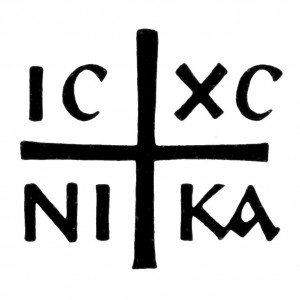 O Master and Lord, help me to desire to truly bow my mind, heart and life to You and embrace the way of living that You taught me through Your life, death and resurrection. Help me to understand that the cross life has given me has been given out of love so that I might have an opportunity to spiritually grow and learn how to be a child of God. Help me not to despair when the challenges of life become intense and learn always to reflect upon Your Cross as a means of strengthening my resolve to carry my cross after You. As I request Your help, O God, I offer my praise to You, Who I know to be Father, Son and Holy Spirit, not only now but forever and ever. Amen.
O Master and Lord, help me to desire to truly bow my mind, heart and life to You and embrace the way of living that You taught me through Your life, death and resurrection. Help me to understand that the cross life has given me has been given out of love so that I might have an opportunity to spiritually grow and learn how to be a child of God. Help me not to despair when the challenges of life become intense and learn always to reflect upon Your Cross as a means of strengthening my resolve to carry my cross after You. As I request Your help, O God, I offer my praise to You, Who I know to be Father, Son and Holy Spirit, not only now but forever and ever. Amen.
My dearest Savior, I beg your help as I attempt to pick up my personal cross and follow You. As I reflect upon the way You lived Your life and death, I know that this is the way I desire to live. Give me the courage to respond to the challenges of my life as You did Yours. Help me to strengthen my resolve to love unconditionally, forgive completely and treat other as I want to be treated. Help me to overcome any complacency I might have about life and strengthen my desire to spiritual grow. I truly desire to follow You, my Lord and God. As I request Your help, O God, I offer my praise to You, Who I know to be Father, Son and Holy Spirit, not only now but forever and ever. Amen.
My most beloved Lord, as I think about Your Cross I am filled with a deep sense of Your love for me and I am humbled. I thank You for the gift of my faith which provides me with the help and hope I need as I continue my life’s journey. To know that I am loved and that life is eternal makes the challenges of this life more manageable. Your Cross, and how You carried it, truly shows me how I must live. Help me to be, at least in some small way, more worthy of Your love and gifts. Help me to know the true meaning of Your Cross. As I request Your help, O God, I offer my praise to You, Who I know to be Father, Son and Holy Spirit, not only now but forever and ever. Amen.
WE BOW TO YOUR CROSS, O MASTER!
AND WE PRAISE YOUR HOLY RESURRECTION!
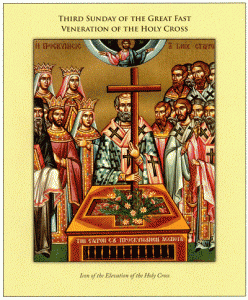 We have almost reached the mid-point of our forty day preparation for the Great Day, Easter. The essential themes of the weekends of this period have been primarily revealed in the Gospel passages. Their sequence, we must remember, was originally connected with preparing converts for initiation into the Church. These lessons are, therefore, an integral part of the early Christian catechesis. They explain and summarize the preparation of the catechumen for the Paschal mystery as experienced in Baptism. Baptism is the entrance into the new life which was inaugurated by Christ. This means that we who prepare ourselves for Pascha do so in our desire to see the inauguration of the new age – to see the manifestation of the Kingdom. But we know this, we will see it only if we believe and repent, if we change our minds, if we have the desire and if we accept the effort.
We have almost reached the mid-point of our forty day preparation for the Great Day, Easter. The essential themes of the weekends of this period have been primarily revealed in the Gospel passages. Their sequence, we must remember, was originally connected with preparing converts for initiation into the Church. These lessons are, therefore, an integral part of the early Christian catechesis. They explain and summarize the preparation of the catechumen for the Paschal mystery as experienced in Baptism. Baptism is the entrance into the new life which was inaugurated by Christ. This means that we who prepare ourselves for Pascha do so in our desire to see the inauguration of the new age – to see the manifestation of the Kingdom. But we know this, we will see it only if we believe and repent, if we change our minds, if we have the desire and if we accept the effort.
This weekend the preparation for the great mystery of Baptism is drawing to its end, the decisive hour of man’s entrance into Christ’s Death and Resurrection is quickly approaching. After this weekend, Lent is no longer the preparation of the catechumen for Baptism, but, although baptized and chrismated, are we not in a sense still catechumens? We return, each year, to this great mystery because we fall away again and again from our awareness of it and its revelation to us about life. The Church, in her infinite wisdom, know that we need this annual journey back to the very roots of our Christian faith in order to help us to continue our spiritual development.
It is interesting to note that the theme of the Cross, which will now be dominate during the remaining days of the Great Fast, is presented not in terms of suffering but of victory and joy. The Church presents for our reflection how Christ endured suffering as a means of helping us develop the ability to endure the suffering that naturally comes with life.
The Great Fast is our self-crucifixion, our experience, limited as it is, of Christ’s commandment heard in the Gospel: If any person would come after me, let him deny himself and take up– his cross and follow me (Mark 8:34). We must seriously ask ourselves what this commandment of Christ means to us. This should be a part of our ongoing reflection from now until the Great Day, Easter.
Twice a year our Church decorates the Holy Cross with flowers and calls us to venerate it by making profound bows before it and kissing it. The first time is on the feast of the Veneration of the Holy Cross (September 14th) and the second is on the Third Weekend of the Great Fast. This practice is a part of our Byzantine liturgical tradition. There is no universal practice on how this is done or what types of flowers are used. The practice is to present the cross in such a fashion that people gain a deep insight into the fact that the Cross of Christ was and still is truly life-giving. That is the essence of this very beautiful custom.
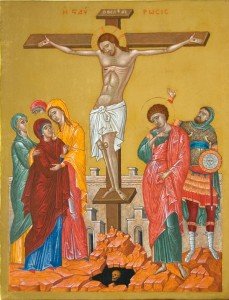 As we know, the Cross, during the era of the Roman Empire, was the ultimate sign of humiliation, cruelty and death. Christ’s crucifixion, voluntarily embraced for our salvation, transformed that horrible sign of death into a beautiful sign of life. Christ’s free embrace of death on the Cross revealed to us the true nature of human life. It was His voluntary embrace of His crucifixion that revealed several things, namely that (1) human suffering, which is a part of earthly life, can be transformed, if accepted in the right way, into a true opportunity for spiritual growth; and (2) human life is immortal, death being only a means of making a transition to a new way of living. One of the main revelations that God made through the Person of Jesus, the Christ, was that we are immortal. He revealed this by going through human death Himself and then rising from the dead. There could have been no better way to reveal this truth to us than by His crucifixion.
As we know, the Cross, during the era of the Roman Empire, was the ultimate sign of humiliation, cruelty and death. Christ’s crucifixion, voluntarily embraced for our salvation, transformed that horrible sign of death into a beautiful sign of life. Christ’s free embrace of death on the Cross revealed to us the true nature of human life. It was His voluntary embrace of His crucifixion that revealed several things, namely that (1) human suffering, which is a part of earthly life, can be transformed, if accepted in the right way, into a true opportunity for spiritual growth; and (2) human life is immortal, death being only a means of making a transition to a new way of living. One of the main revelations that God made through the Person of Jesus, the Christ, was that we are immortal. He revealed this by going through human death Himself and then rising from the dead. There could have been no better way to reveal this truth to us than by His crucifixion.
This is one of the reasons why our Church never separates the Crucifixion from the Resurrection. Think about the prayer we sing today before the Cross: We bow to the Cross, the instrument of His death, and, praise His resurrection. As we do this, we are called to reflect upon this revealed truth and to embrace it with deep faith.
So the symbolism that our Church uses to convey this truth is to intertwine the Cross, the symbol of death, with one of the ultimate symbols of life, flowers. When you think about it, what better symbolism could there ever be to convey this truth. Flowers convey the beauty of life even in the midst of suffering and death. Flowers bring a sweet aroma to death and, at the same time, signal the potential of rebirth. Think about the life-cycle of many types of flowers. They grow, bloom and die only to grow and bloom again. Our Church has chosen to use symbols which can allow us to experience in a real way the meaning of life
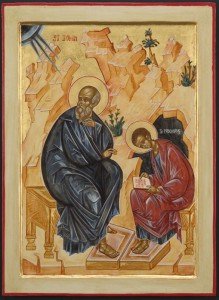 The next book in the chronologically ordered New Testament is the Gospel of John. While John’s Gospel is different from the synoptic gospels, its language has shaped Christian understandings of Jesus and his significance perhaps even more than the first three gospels. Its language is both familiar and beloved by many Christians.
The next book in the chronologically ordered New Testament is the Gospel of John. While John’s Gospel is different from the synoptic gospels, its language has shaped Christian understandings of Jesus and his significance perhaps even more than the first three gospels. Its language is both familiar and beloved by many Christians.
Consider these things in John’s Gospel:
Jesus is the Word of God become flesh — the Word that was in the beginning with God and was God. The language is not only familiar, but also the basis of the Christian doctrine of the Incarnation.
Probably the best-known verse in the New Testament is John 3:16: For God so loved the world that he gave His only Son, so that everyone who believes in Him may not perish but may have eternal life. It is often quoted as a summary of the Christian message and even shows up behind the goal posts at professional football games.
John’s well-known stories include the wedding feast at Cana where Jesus changed water into wine; Nicodemus and the teaching on being born again; the Samaritan woman at the well; Lazarus and resurrection; Jesus’ appearance to Mary Magdalene near the empty tomb and his showing of his wounds to doubting Thomas.
John’s series of I AM statements presents familiar metaphors for Jesus: the Bread of Life; the Light of the World; the Good Shepherd; the Gate or the Door; the Resurrection and the Life; the Way and the Truth; the Life; the True Vine; and also simply I AM. Because John presents these as statements of Jesus, Christians for centuries have taken it for granted that Jesus said these things about Himself.
None of the above is found in the synoptic gospels. Moreover, there are other differences. In the synoptics Jesus frequently teaches with parables. In john, He does not. Instead, He often speaks in extended and complex discourses. One is five chapters long. In the synoptics, Jesus is an exorcist. In John, there are no exorcisms. In the synoptics, Jesus’ public activity is mostly in Galilee. Only his final journey to Jerusalem takes him south to Judea. In John, Jesus has several periods of public activity in Judea and Jerusalem. In the synoptics, there is one Passover; in John, three. And, perhaps most strikingly, in the synoptics Jesus’ divine identity and status are not part of his teaching. In John they are.
Again, we must always remember that all of the gospels were written for different reasons and even different audiences. They are not history, although based on history.
![]() I have tried to present the Greek patristic view of original sin as inherited mortality which provides a new meaning to Christ’s death and resurrection. Christ had to die in order to eliminate mortality and reveal to us that human life is immortal. For the resurrection of Christ means indeed that death has ceased to be the controlling element of man’s existence and that, therefore, man is also free from slavery to sin. While Death certainly remains as a physical phenomenon, it does not dominate man as an unavoidable and ultimate fate: As in Adam all die, so also in Christ shall all be made alive. And Athanasius writes: Henceforth we are dissolved for a time only according to our bodies’ mortal nature, in order to better to receive resurrection; like seeds cast into the earth, we do not perish, but sown in the earth we shall rise again, since death has been brought to naught by the grace of the Savior. And John Chrysostom writes: It is true, we still die as before, but we do not remain in death; and this is not to die. The power and the very reality of death are just this, that a dead man has no possibility of returning to life. But if after death he is to be quickened and, moreover to be given a better life, then this is no longer death, but a falling asleep. Since death has ceased to be the only possible end of existence, man is free from fear and sin. The vicious circle was broken on Easter Sunday and is broken each time the death of Christ is announced and His resurrection is confessed.
I have tried to present the Greek patristic view of original sin as inherited mortality which provides a new meaning to Christ’s death and resurrection. Christ had to die in order to eliminate mortality and reveal to us that human life is immortal. For the resurrection of Christ means indeed that death has ceased to be the controlling element of man’s existence and that, therefore, man is also free from slavery to sin. While Death certainly remains as a physical phenomenon, it does not dominate man as an unavoidable and ultimate fate: As in Adam all die, so also in Christ shall all be made alive. And Athanasius writes: Henceforth we are dissolved for a time only according to our bodies’ mortal nature, in order to better to receive resurrection; like seeds cast into the earth, we do not perish, but sown in the earth we shall rise again, since death has been brought to naught by the grace of the Savior. And John Chrysostom writes: It is true, we still die as before, but we do not remain in death; and this is not to die. The power and the very reality of death are just this, that a dead man has no possibility of returning to life. But if after death he is to be quickened and, moreover to be given a better life, then this is no longer death, but a falling asleep. Since death has ceased to be the only possible end of existence, man is free from fear and sin. The vicious circle was broken on Easter Sunday and is broken each time the death of Christ is announced and His resurrection is confessed.
But what does being in Christ mean concretely? A quotation from the Anaphora of St. Basil’s Liturgy suggest this: through Baptism, Chrismation and the Eucharist, man freely becomes a member of the risen Body of Christ. The element of freedom and also even that of consciousness – is truly essential to the doctrine of salvation as understood by the Byzantine patristic, sacramental and liturgical tradition. On the one hand, there are emphatic affirmations of the universality of redemption. Gregory of Nyssa, says: As the principle of death took its rise in one person and passed on in succession through the whole of the human nature, so the principle of the Resurrection extends from one person to the whole of humanity. This is the mystery of God’s plan with regard to His death and His resurrection from the dead, and his thoughts on the universality of redemption and recapitulation are echoed by Maximus the Confessor.
Think about what the Fathers said. Their view is our view as an Eastern Church. Do you understand the real difference of the Eastern viewpoint? There is not only one correct view of what God revealed through Jesus!
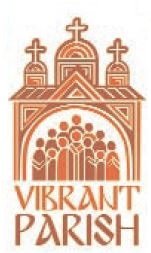 The final help that we have in responding to the call to holiness is prayer and hope. We do not have to be long on the spiritual journey before we find that it is very unpredictable. It is not under our control. Our most carefully thought-out decisions can go awry at a moment’s notice. At times like this, as well as when we are trying to discern what we are to do, hope helps us realize that God has been in our lives all along. God has been faithful in the relationship, and God will continue to be faithful. This realization gives us hope for the moment of grace (i.e. help) in every difficult decision.
The final help that we have in responding to the call to holiness is prayer and hope. We do not have to be long on the spiritual journey before we find that it is very unpredictable. It is not under our control. Our most carefully thought-out decisions can go awry at a moment’s notice. At times like this, as well as when we are trying to discern what we are to do, hope helps us realize that God has been in our lives all along. God has been faithful in the relationship, and God will continue to be faithful. This realization gives us hope for the moment of grace (i.e. help) in every difficult decision.
Hope has been defined as that mental habit through which a person both desires and expects the fulfillment of God’s promises of things to come. Of course you have to be aware of what God’s promises are. I’m not sure that many of us think about the promises that God has made to us through the Person of Jesus. What did He promise?
He promised that the Holy Spirit would be our Advocate, that is someone Who would provide us help when we were in need of assistance in dealing with one of life’s challenges. This help might come in a number of different ways: a person who might provide us support; a word or thought that we might hear; an insight we might have; something written that we just seem to stumble upon; or even a serendipitous happening. God’s help is always coming to us. The problem is that we don’t always recognize it. There are really no coincidences, I believe, in life. All the things that happen to us, all of the experiences we have, are designed to support us on our journey and help us to spiritually grow. Of course we have to be looking for, expecting and believing that God will help us.
Prayer, communication with God, is helpful not so much as we ask for guidance, but as we are quiet and listen for the Loved One. God knows our needs better than we do. God knows the consequences of all the options we have. But God seldom intrudes on our decision in an overt, noisy way. Usually, God’s guidance comes through insight when we are quiet.
